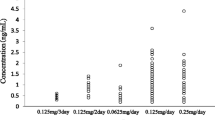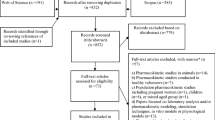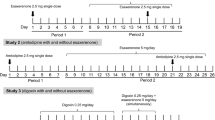Summary
Digoxin intoxication occurs frequently and may require treatment with digoxin-specific Fab therapy. Little is known, however, regarding the biological fate of this compound. Pharmacokinetic studies have not been performed in healthy volunteers, but there are limited kinetic data from patients who have received therapy for the treatment of digoxin toxicity. Digoxin-specific Fab is eliminated via renal and nonrenal routes, having a volume of distribution slightly exceeding extracellular volume (0.40 L/kg) and an elimination half-life of 16 to 20 hours. Patients with renal impairment and end-stage renal disease have elimination half-life values that are prolonged up to 10-fold in magnitude, while volume of distribution is unaffected. Systemic clearance of digoxin-specific Fab is approximately 0.32 ml/min/kg in digoxin-toxic patients with preserved renal function. Renal failure also decreases Fab clearance by up to 75%. Therefore, Fab may reside in the serum of anephric patients for 2 to 3 weeks after administration.
More important is the effect of Fab on the disposition of digoxin. Because digoxin-specific Fab has a stronger digoxin-binding affinity than do biological membranes, it can sequester tissue-bound and intracellular digoxin into the extracellular spaces. This results in a rapid increase in digoxin serum concentrations in the central compartment. Since the majority of digoxin is bound by Fab, it cannot interact with its biological receptor and thus reverses digoxin toxicity.
The pharmacokinetic fate of total digoxin after administration of digoxin-specific Fab follows that of Fab. However, it appears that the elimination half-life of Fab is slightly shorter than that of total digoxin in patients with end-stage renal disease, suggesting that the clearance of Fab is slightly faster than that of total digoxin. Free digoxin concentrations fall rapidly after Fab administration and then rebound upwards within 12 to 24 hours. This rebound in free digoxin concentrations, however, is delayed by 12 to 130 hours in patients with renal dysfunction and end-stage renal disease. Rebound in free digoxin concentrations occurs during the initial phase of the biexponential decline of the serum concentration-time profile for digoxin-specific Fab, suggesting that distribution from the vascular spaces is the likely cause. Following the increase, free digoxin concentrations decline in a manner that is dependent on renal and nonrenal routes of elimination. During this time period it is evident that Fab retains its capability of binding digoxin while it resides in plasma.
There is no evidence to support a dissociation between the Fab-digoxin complex over extended periods of time. This was demonstrated in a report where the free fraction of digoxin, in the presence of Fab remained less than the free fraction in the absence of Fab. Recent evidence also supports the role of monitoring free digoxin concentrations in certain patients who received digoxin-specific Fab therapy as they are more predictive of the pharmacological activity of digoxin than either total or bound digoxin concentrations. Indeed, free digoxin concentrations correlate with recurrences of digoxin toxicity, the need for supplemental Fab doses, and the efficacy of digoxin therapy initiated during Fab therapy.
Similar content being viewed by others
References
Mahdyoon H, Battilana G, Rosman H, et al. The evolving pattern of digoxin intoxication: observations at a large urban hospital from 1980-1988. Am Heart J 1990; 120(5): 1189–94
Kernan WN, Castellsague J, Periman GD, et al. Incidence of hospitalization for digitalis toxicity among elderly Americans. Am J Med 1994; 95: 426–31
Ujhelyi MR, Curry RW, Robinson JD. Management of unusually high serum digoxin concentrations. Drug Intell Clin Pharm 1988; 22: 345–6
Wenger TL, Butler VP, Haber E, et al. Treatment of 63 severely digitalis-toxic patients with digoxin-specific antibody fragments. J Am Coll Cardiol 1985; 5: 118A–23A
Smith TW, Lloyd BL, Haer E. Immunogenicity and kinetics of distribution and elimination of sheep digoxin-specific IgG and Fab fragments in the rabbit and baboon. Clin Exp Immunol 1979; 36: 384–96
Butler VP, Schmidt DH, Smith TW, et al. Effects of sheep digoxin-specific antibodies and their Fab fragments on digoxin pharmacokinetics in dogs. J Clin Invest 1977; 59: 345–59
Schaumann W, Kaufmann B, Neubert P, et al. Kinetics of the Fab fragments of digoxin antibodies and of bound digoxin in patients with severe digoxin intoxication. Eur J Clin Pharmacol 1986; 30: 527–33
Allen NM, Dunham GD, Sailstad JM, et al. Clinical and pharmacokinetic profiles of digoxin immune Fab in four patients with renal impairment. DICP 1991; 25: 1315–20
Ujhelyi MR, Robert S, Cummings DM, et al. Disposition of digoxin immune Fab in patients with kidney failure. Clin Pharmacol Ther 1993; 54: 388–94
Sinclair AJ, Hewick DS, Johnston PC, et al. Kinetics of digoxin and anti-digoxin antibody fragments during treatment of digoxin toxicity. Br J Clin Pharmacol 1989; 28: 352–6
Erdmann E, Mair W, Knedel M, et al. Digitalis intoxication and treatment with digoxin antibody fragments in renal failure. Klin Wochenschr 1989; 67: 16–9
Cockcroft DW, Gault MH. Prediction of creatinine clearance from serum creatinine. Nephron 1976; 16: 31–41
Rabetoy GM, Price CA, Findlay JWA, et al. Treatment of digoxin intoxication in a renal failure patient with digoxin-specific antibody fragments and plasmapheresis. Am J Nephrol 1990; 10: 518–21
Quaife EJ, Banner W, Vernon DD, et al. Failure of CAVH to remove digoxin-Fab complex in piglets. Clin Toxicol 1990; 28(1): 61–8
Wochner RD, Stober W, Waldmann TA. The role of the kidney in the catabolism of Bence Jones proteins and immunoglobulin fragments. J Exp Med 1967; 126: 207–21
Matzke GR, Millikin SP. Influence of renal function and dialysis on drug disposition. In: Evans WE, Schentag JJ, Jusko WJ, editors. Applied pharmacokinetics: principles of therapeutic drug monitoring, 3rd ed. Vancouver, WA: Applied Therapeutics Inc., 1992: 8.1–8.49
Allen NM, Dunham GD. Treatment of digitalis intoxication with emphasis on the clinical use of digoxin immune Fab. DICP 1990; 24: 991–8
Digibind: product information. Research Triangle Park, NC: Burroughs Wellcome Co., 1988
Rainey PM. Effects of digoxin immune Fab (ovine) on digoxin immunoassays. Am J Clin Pathol 1989; 92: 779–86
Antman EM, Wenger TL, Butler VP, et al. Treatment of 150 cases of life-threatening digitalis intoxication with digoxin-specific Fab antibody fragments. Circulation 1990; 81: 1744–52
Watson JF, Butler VP. Biologic activity of digoxin-specific antisera. J Clin Invest 1972; 51: 638–48
Gardner JD, Kiino DR, Swartz TJ, et al. Effects of digoxin-specific antibodies on accumulation and binding of digoxin by human erythrocytes. J Clin Invest 1973; 52: 1820–33
Smith TW, Haber E, Yeatman L, et al. Reversal of advanced digoxin intoxication with Fab fragments of digoxin-specific antibodies. N Engl J Med 1976; 294(15): 797–800
Smolarz A, Roesch E, Lenz E, et al. Digoxin specific antibody (Fab) fragments in 34 cases of severe digitalis intoxication. J Toxicol Clin Toxicol 1985; 23(4–6): 327–40
Nuwayhid NF, Johnson GF. Digoxin elimination in a functionally anephric patient after digoxin-specific Fab fragment therapy. Ther Drug Monit 1989; 11: 680–5
Colucci RD, Chow MSS, Kluger J, et al. The pharmacokinetics of digoxin immune Fab, total digoxin and free digoxin in patients with renal impairment [abstract]. Pharmacotherapy 1989; 9(13): 175
Hursting MJ, Raisys VA, Opheim KE, et al. Determination of free digoxin concentrations in serum for monitoring Fab treatment of digoxin overdose. Clin Chem 1987; 33(9): 1652–5
Ujhelyi MR, Green PJ, Cummings DM, et al. Determination of free serum digoxin concentrations in digoxin toxic patients after administration of digoxin Fab antibodies. Ther Drug Monit 1992; 14(2): 147–54
Ujhelyi MR, Colucci RD, Cummings DM, et al. Monitoring serum digoxin concentrations during digoxin immune Fab therapy. DICP 1991; 25: 1047–9
Ujhelyi MR, Robert S, Cummings DM, et al. Influence of digoxin immune Fab therapy and renal dysfunction on the disposition of total and free digoxin. Ann Int Med 1993: 119(4): 273–7
Clifton GD, McIntyre WJ, Zannikos PN, et al. Free and total serum digoxin concentrations in a renal failure patient after treatment with digoxin immune Fab. Clin Pharm 1989; 8: 441–5
Urtizberea M, Sabouraud A, Lachaise M, et al. Pharmacokinetics of total and free digoxin and Fab fragments in 5 intoxicated patients after administration of specific anti-digoxin Fab fragments. Arch Toxicol 1991; 14 (Suppl.): 132–5
Ujhelyi MR, Cummings DM, Green PJ, et al. Effect of digoxin Fab antibodies on five digoxin immunoassays. Ther Drug Monit 1990; 12: 288–92
Hansell JR. Effect of therapeutic digoxin antibodies on digoxin assays. Arch Pathol Lab Med 1989; 113: 1259–62
Gibb I, Adams PC, Parnham AJ, et al. Plasma digoxin: assay anomalies in Fab treated patients. Br J Clin Pharmacol 1983; 16: 445–7
Hursting MJ, Raisys VA, Opheim KE, et al. Determination of free digoxin concentrations in serum for monitoring Fab treatment of digoxin overdose. Clin Chem 1987; 33: 1652–5
Christenson RH, Studenberg SD, Beck-Davis S, et al. Digoxin-like immunoreactivity eliminated from serum by centrifugal ultrafiltration before fluorescence polarization immunoassay of digoxin. Clin Chem 1987; 33: 606–8
Ujhelyi M. Management of digitalis intoxicated patients following the administration of digoxin Fab antibodies (Digibind). Conn Med 1990; 54(2): 63–4
Allen NM. Retreatment with digoxin immune Fab. Clin Pharm 1991; 10: 823–4
Hickey AR, Wenger TL, Carpenter VP, et al. Digoxin immune Fab therapy in the management of digitalis intoxication: safety and efficacy results of an observational surveillance study. J Am Coll Cardiol 1991; 17: 590–8
Wenger TL. Clinical experience with digoxin immune Fab (ovine). Prim Cardiol 1988; 1: 19–23
Ochs HR, Vatner SF, Smith TW. Reversal of inotropic effects of digoxin by specific antibodies and their Fab fragments in the conscious dog. J Pharmacol Exp Ther 1978; 207: 64–71
Robert S, Ujhelyi MR, Zarowitz BJ. Reinstitution of digoxin after digoxin Fab antibody therapy in a hemodialyzed patient. Crit Care Med 1993; 21(10): 1585–7
Ohnhaus EE, Spring P, Dettli L. Protein binding of digoxin in human serum. Eur J Clin Pharmacol 1972; 5: 34–6
Author information
Authors and Affiliations
Rights and permissions
About this article
Cite this article
Ujhelyi, M.R., Robert, S. Pharmacokinetic Aspects of Digoxin-Specific Fab Therapy in the Management of Digitalis Toxicity. Clin. Pharmacokinet. 28, 483–493 (1995). https://doi.org/10.2165/00003088-199528060-00006
Published:
Issue Date:
DOI: https://doi.org/10.2165/00003088-199528060-00006




